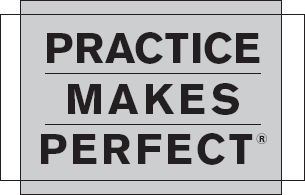German Problem Solver
Ed Swick
New York Chicago San Francisco Lisbon London Madrid Mexico City
Milan New Delhi San Juan Seoul Singapore Sydney Toronto
Copyright 2013 by The McGraw-Hill Companies, Inc. All rights reserved. Except as permitted under the United States Copyright Act of 1976, no part of this publication may be reproduced or distributed in any form or by any means, or stored in a database or retrieval system, without the prior written permission of the publisher.
ISBN: 978-0-07-179116-8
MHID: 0-07-179116-7
The material in this eBook also appears in the print version of this title: ISBN: 978-0-07-179115-1, MHID: 0-07-179115-9.
McGraw-Hill, the McGraw-Hill Publishing logo, Practice Makes Perfect, and related trade dress are trademarks or registered trademarks of The McGraw-Hill Companies and/or its affiliates in the United States and other countries and may not be used without written permission. All other trademarks are the property of their respective owners. The McGraw-Hill Companies is not associated with any product or vendor mentioned in this book.
McGraw-Hill eBooks are available at special quantity discounts to use as premiums and sales promotions, or for use in corporate training programs. To contact a representative please e-mail us at .
TERMS OF USE
This is a copyrighted work and The McGraw-Hill Companies, Inc. (McGrawHill) and its licensors reserve all rights in and to the work. Use of this work is subject to these terms. Except as permitted under the Copyright Act of 1976 and the right to store and retrieve one copy of the work, you may not decompile, disassemble, reverse engineer, reproduce, modify, create derivative works based upon, transmit, distribute, disseminate, sell, publish or sublicense the work or any part of it without McGraw-Hills prior consent. You may use the work for your own noncommercial and personal use; any other use of the work is strictly prohibited. Your right to use the work may be terminated if you fail to comply with these terms.
THE WORK IS PROVIDED AS IS. McGRAW-HILL AND ITS LICENSORS MAKE NO GUARANTEES OR WARRANTIES AS TO THE ACCURACY, ADEQUACY OR COMPLETENESS OF OR RESULTS TO BE OBTAINED FROM USING THE WORK, INCLUDING ANY INFORMATION THAT CAN BE ACCESSED THROUGH THE WORK VIA HYPERLINK OR OTHERWISE, AND EXPRESSLY DISCLAIM ANY WARRANTY, EXPRESS OR IMPLIED, INCLUDING BUT NOT LIMITED TO IMPLIED WARRANTIES OF MERCHANTABILITY OR FITNESS FOR A PARTICULAR PURPOSE. McGraw-Hill and its licensors do not warrant or guarantee that the functions contained in the work will meet your requirements or that its operation will be uninterrupted or error free. Neither McGraw-Hill nor its licensors shall be liable to you or anyone else for any inaccuracy, error or omission, regardless of cause, in the work or for any damages resulting therefrom. McGraw-Hill has no responsibility for the content of any information accessed through the work. Under no circumstances shall McGraw-Hill and/or its licensors be liable for any indirect, incidental, special, punitive, consequential or similar damages that result from the use of or inability to use the work, even if any of them has been advised of the possibility of such damages. This limitation of liability shall apply to any claim or cause whatsoever whether such claim or cause arises in contract, tort or otherwise.
Contents
Preface
This book is aptly named a problem solver. Unlike other approaches to the German language, this book does not look at all aspects of German grammar and structure; rather, it isolates those things in the language that English speakers find problematic. It then describes them, analyzes the complexities that cause consternation, and provides explanations and examples of how the problem areas work.
There are nineteen chapters in the book that delve into nineteen specific areas of difficulty. After these areas have been described, explained, and illustrated, they are placed in a wide variety of exercises, in which the reader can manipulate the problem areas and become more familiar with how they function and thereby take control of them. If a particular subject still seems difficult after working through a chapter, the reader should simply repeat the chapter and practice with the exercises again.
German irregular verbs are a special problem for English speakers, even though the English language has numerous irregular verbs that are similar to German verbs. To make working with German irregular verbs more convenient, the reader will find an appendix comprising a list of all irregular verbs in German. This appendix shows the verb in its infinitive form, with any present tense irregularity, in its past tense, in its participial form, and as a subjunctive II conjugation. This resource will prove to be essential for working with verbs in this book.
The twentieth chapter of the book does not discuss a specific problem area or describe any particular linguistic difficulty in German. Instead, it is a miniature linguistic laboratory that the reader can use to practice all aspects of the language simultaneously. German, like any language, is not a random series of conjugations, declensions, and usages of vocabulary. It is a combination of all those things that make communication in the language comprehensible and accurate. Therefore, in the twentieth chapter the reader will be writing creatively and not just practicing with isolated concepts. The exercises are not for grammatical or vocabulary practice; rather, they are a forum for the reader to apply his or her knowledge of German in a personal way. Of course, there will be some guidelines for this type of creative writing, but generally the reader will have ample opportunities to experiment in writing.
This series of books is intentionally called Practice Makes Perfect because that idea is basic to learning and mastering a new language. bung macht den Meister.
Acknowledgment
I would like to express my gratitude to my friend Stefan Feyen for his generous help and suggestions.
Determining gender and forming plurals | |
Many who are learning German struggle with the seemingly illogical approach that the language takes when determining gender. This is particularly true for English speakers, who are accustomed to a simple method for assigning gender to a noun: If the noun refers to a male, its masculine. If it refers to a female, it s feminine. And if it refers to an inanimate object, the noun is neuter. There are a few exceptions, but for the most part, gender in the English language is determined by the obvious sexual gender of a person or the fact that an object is inanimate.
In small measure, German often considers males and females as masculine and feminine nouns, respectively. This is easy for an English speaker to understand. But it is the other ways of assigning gender to a noun that cause consternation. There often seems to be no rhyme or reason for why a noun is assigned a certain gender. But that is only what it seems. Let s look at the various patterns to German gender, which will help make sense of why a noun is considered masculine, feminine, or neuter.










